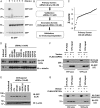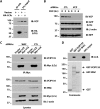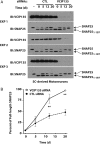Deubiquitinating enzyme VCIP135 dictates the duration of botulinum neurotoxin type A intoxication
- PMID: 28584101
- PMCID: PMC5495235
- DOI: 10.1073/pnas.1621076114
Deubiquitinating enzyme VCIP135 dictates the duration of botulinum neurotoxin type A intoxication
Abstract
Botulism is characterized by flaccid paralysis, which can be caused by intoxication with any of the seven known serotypes of botulinum neurotoxin (BoNT), all of which disrupt synaptic transmission by endoproteolytic cleavage of SNARE proteins. BoNT serotype A (BoNT/A) has the most prolonged or persistent effects, which can last several months, and exerts its effects by specifically cleaving and inactivating SNAP25. A major factor contributing to the persistence of intoxication is the long half-life of the catalytic light chain, which remains enzymatically active months after entry into cells. Here we report that BoNT/A catalytic light chain binds to, and is a substrate for, the ubiquitin ligase HECTD2. However, the light chain evades proteasomal degradation by the dominant effect of a deubiquitinating enzyme, VCIP135/VCPIP1. This deubiquitinating enzyme binds BoNT/A light chain directly, with the two associating in cells through the C-terminal 77 amino acids of the light chain protease. The development of specific DUB inhibitors, together with inhibitors of BoNT/A proteolytic activity, may be useful for reducing the morbidity and public health costs associated with BoNT/A intoxication and could have potential biodefense implications.
Keywords: USP9X; motoneuron; synaptic transmission; synaptosomal-associated protein 25; toxin persistence.
Conflict of interest statement
Conflict of interest statement: G.A.O. has a financial interest in Synaptic Research LLC, which is developing therapeutics for BoNT intoxication, including the delivery of designer ubiquitin ligases.
Figures










Similar articles
-
Targeting botulinum neurotoxin persistence by the ubiquitin-proteasome system.Proc Natl Acad Sci U S A. 2010 Sep 21;107(38):16554-9. doi: 10.1073/pnas.1008302107. Epub 2010 Sep 7. Proc Natl Acad Sci U S A. 2010. PMID: 20823219 Free PMC article.
-
Screening of a Focused Ubiquitin-Proteasome Pathway Inhibitor Library Identifies Small Molecules as Novel Modulators of Botulinum Neurotoxin Type A Toxicity.Front Pharmacol. 2021 Sep 27;12:763950. doi: 10.3389/fphar.2021.763950. eCollection 2021. Front Pharmacol. 2021. PMID: 34646144 Free PMC article.
-
Natural Compounds and Their Analogues as Potent Antidotes against the Most Poisonous Bacterial Toxin.Appl Environ Microbiol. 2018 Nov 30;84(24):e01280-18. doi: 10.1128/AEM.01280-18. Print 2018 Dec 15. Appl Environ Microbiol. 2018. PMID: 30389764 Free PMC article.
-
8-Hydroxyquinoline and hydroxamic acid inhibitors of botulinum neurotoxin BoNT/A.Curr Top Med Chem. 2014;14(18):2094-102. doi: 10.2174/1568026614666141022095114. Curr Top Med Chem. 2014. PMID: 25335884 Review.
-
Recent advances in botulinum neurotoxin inhibitor development.Curr Top Med Chem. 2014;14(18):2044-61. doi: 10.2174/1568026614666141022093350. Curr Top Med Chem. 2014. PMID: 25335887 Review.
Cited by
-
Characterization of Serotype CD Mosaic Botulinum Neurotoxin in Comparison with Serotype C and A.Toxins (Basel). 2023 Feb 3;15(2):123. doi: 10.3390/toxins15020123. Toxins (Basel). 2023. PMID: 36828437 Free PMC article.
-
Ubiquitin-Proteasome System in the Different Stages of Dominantly Inherited Alzheimer's Disease.Res Sq [Preprint]. 2024 Jul 23:rs.3.rs-4202125. doi: 10.21203/rs.3.rs-4202125/v1. Res Sq. 2024. Update in: Alzheimers Dement. 2025 May;21(5):e70243. doi: 10.1002/alz.70243. PMID: 39108475 Free PMC article. Updated. Preprint.
-
Botulinum and Tetanus Neurotoxins.Annu Rev Biochem. 2019 Jun 20;88:811-837. doi: 10.1146/annurev-biochem-013118-111654. Epub 2018 Nov 2. Annu Rev Biochem. 2019. PMID: 30388027 Free PMC article. Review.
-
Light Chain Diversity among the Botulinum Neurotoxins.Toxins (Basel). 2018 Jul 2;10(7):268. doi: 10.3390/toxins10070268. Toxins (Basel). 2018. PMID: 30004421 Free PMC article. Review.
-
Update on Non-Interchangeability of Botulinum Neurotoxin Products.Toxins (Basel). 2024 Jun 10;16(6):266. doi: 10.3390/toxins16060266. Toxins (Basel). 2024. PMID: 38922160 Free PMC article. Review.
References
-
- Simpson LL. Identification of the characteristics that underlie botulinum toxin potency: Implications for designing novel drugs. Biochimie. 2000;82:943–953. - PubMed
-
- Habermann E, Dreyer F. Clostridial neurotoxins: Handling and action at the cellular and molecular level. Curr Top Microbiol Immunol. 1986;129:93–179. - PubMed
-
- Johnson EA, Montecucco C. Botulism. Handb Clin Neurol. 2008;91:333–368. - PubMed
-
- Schiavo G, Matteoli M, Montecucco C. Neurotoxins affecting neuroexocytosis. Physiol Rev. 2000;80:717–766. - PubMed
-
- Montecucco C, Schiavo G. Structure and function of tetanus and botulinum neurotoxins. Q Rev Biophys. 1995;28:423–472. - PubMed
Publication types
MeSH terms
Substances
Grants and funding
LinkOut - more resources
Full Text Sources
Other Literature Sources
Medical
Molecular Biology Databases

